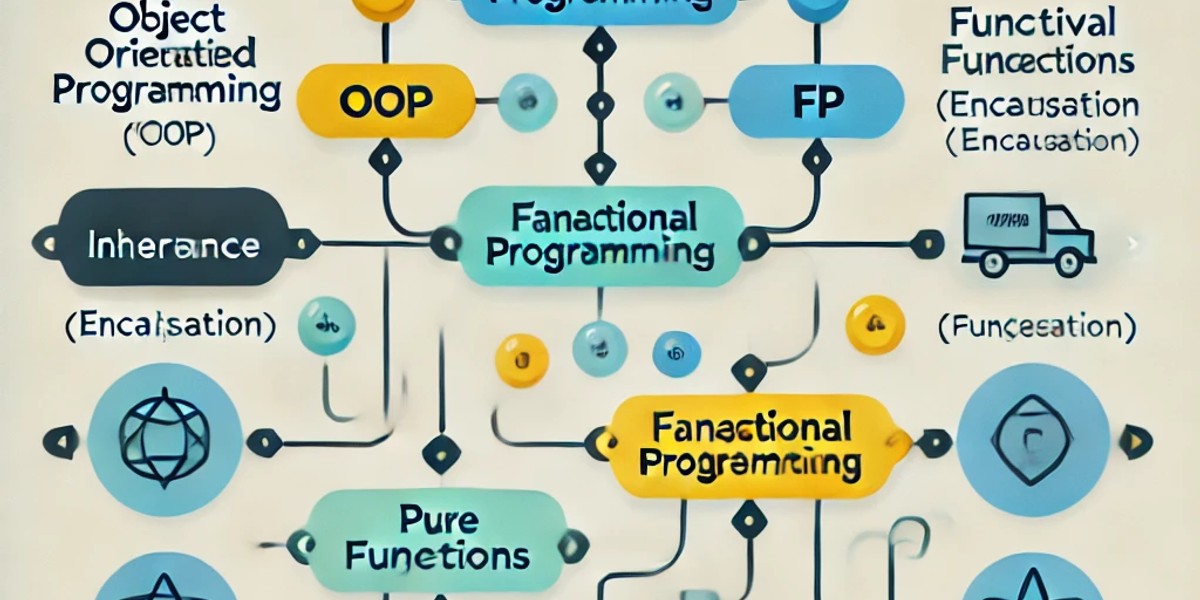Mastering JavaScript Programming Paradigms: OOP vs Functional Programming

A comprehensive comparison of Object-Oriented and Functional Programming approaches in JavaScript.
JavaScript is a versatile language that offers different ways to solve problems, but two of the most prominent approaches are Object-Oriented Programming (OOP) and Functional Programming (FP). Each paradigm has its unique way of organizing and thinking about code, and both have their strengths and weaknesses.
Whether you're building a game, a web app, or processing data, understanding these paradigms will help you write cleaner, more efficient, and maintainable code. This post will guide you through an in-depth exploration of OOP and FP in JavaScript, showing you the patterns, pros, and cons of each approach.
Object-Oriented Programming (OOP): Structuring Code Around Objects
OOP is like building with LEGO blocks – you create objects (blocks) that have both properties (characteristics) and methods (actions). This makes it easier to model real-world concepts, making your code more intuitive and easier to manage, especially as it scales.
Key Concepts of OOP
1. **Classes and Objects**
In OOP, a class is a blueprint for creating objects. Objects are instances of these classes.
Example
drive() { console.log(`${this.make} ${this.model} is driving`); }}
// Creating objects (instances) from the classconstmyCar=newCar("Toyota", "Corolla");myCar.drive(); // Output: "Toyota Corolla is driving"```
Classes make it easy to create multiple objects with similar characteristics and behaviors, such as cars in our example.
#### 2. **Inheritance**
Inheritance allows one class to extend another, reusing its properties and methods. It’s like children inheriting features from their parents.
##### Example
```javascript// Parent classclassAnimal {speak() { console.log("The animal makes a sound"); }}
// Child class that inherits from AnimalclassDogextendsAnimal {speak() { console.log("The dog barks"); }}
constdog=newDog();dog.speak(); // Output: "The dog barks"```
##### Pros:
- Reusability of code- Simplifies complex structures
##### Cons:
- Can lead to tightly coupled code- Overuse can make debugging difficult
---
### Common OOP Patterns in JavaScript
#### The Singleton Pattern
This pattern ensures there is only one instance of a class throughout your application.
```javascriptclassDatabase {constructor() {if (Database.instance) return Database.instance; Database.instance =this; }}
constdb1=newDatabase();constdb2=newDatabase();console.log(db1 === db2); // Output: true```
### Pros and Cons of OOP
| **Pros** | **Cons** || ------------------------------------- | --------------------------------------------- || Models real-world problems naturally | Can become complicated with large hierarchies || Encourages code reuse and modularity | Can lead to tightly coupled code || Great for projects with complex state | Requires more boilerplate code |
---
## Functional Programming (FP): Treating Code as a Series of Transformations
FP treats computation as the evaluation of mathematical functions, avoiding changing state and mutable data. It emphasizes writing functions that are predictable and reusable.
### Key Concepts of FP
#### 1. **Pure Functions**
A pure function always produces the same output for the same input and has no side effects (it doesn’t change anything outside of itself).
##### Example
```javascript// Pure function examplefunctionadd(a, b) {return a + b;}```
Pure functions are easier to test and debug since they’re predictable.
#### 2. **Immutability**
In FP, data is never changed directly. Instead, you create new versions of data.
##### Example
```javascript// Immutable operationconstnumbers= [1, 2, 3];constnewNumbers= [...numbers, 4];console.log(numbers); // Output: [1, 2, 3]console.log(newNumbers); // Output: [1, 2, 3, 4]```
#### 3. **Higher-Order Functions**
These are functions that take other functions as arguments or return them.
##### Example
```javascript// Higher-order function examplefunctionapplyOperation(arr, operation) {return arr.map(operation);}
constresult=applyOperation([1, 2, 3], (num) => num *2);console.log(result); // Output: [2, 4, 6]```
---
### Common FP Patterns in JavaScript
#### Function Composition
Combining multiple simple functions to build more complex ones.
```javascriptconstmultiplyBy2= (x) => x *2;constadd3= (x) => x +3;
constmultiplyAndAdd= (x) =>add3(multiplyBy2(x));console.log(multiplyAndAdd(5)); // Output: 13```
### Pros and Cons of FP
| **Pros** | **Cons** || ------------------------------- | -------------------------------------------------------------- || Predictable, testable functions | Can be less intuitive for complex state changes || Reduces side effects | Can lead to more complex function compositions || Emphasizes code reusability | Sometimes less efficient with memory usage due to immutability |
---
## Comparing OOP and FP
| **Aspect** | **OOP** | **FP** || -------------- | ---------------------------------- | ---------------------------------------------- || Data Handling | Mutable | Immutable || Code Structure | Based on objects and methods | Based on functions and transformations || Best Use Cases | Complex UI, games, apps with state | Data processing, calculations, stateless tasks |
---
### Final Thoughts
Both OOP and FP have their places in JavaScript development. While OOP is excellent for modeling real-world entities and relationships, FP shines when you want predictable, reusable, and testable code. The beauty of JavaScript is that you don’t have to choose one or the other – you can mix and match these paradigms to suit your project's needs.
By understanding these paradigms and patterns, you’ll have a more powerful toolkit for writing maintainable, efficient, and scalable JavaScript code.